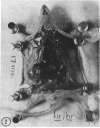Abstract
Leukemia was observed in 45 per cent of hairless mice at 8 to 10 months of age and 72 per cent at 18 months. The incidence of leukemia in normal heterozygous mice of the same age is about one per cent at 10 months and increases to 20 per cent at 18 months. Other tumors are rare; two mammary adenocarcinomas occurred in heterozygotes, and an epidermal squamous cell carcinoma was found in a hairless mouse. Murine leukemia virus was isolated from normal and leukemic mice of both genotypes on SWR/J- and C57L/J-METC, but not BALB/cJ-METC. If this virus is responsible for the leukemia in HRS/J mice, the mutant gene (hr) enhances susceptibility and the wild-type allele (+) induces resistance to leukemogenesis, i.e., malignant transformation of reticulo-endothelial tissues occurs rather than inhibition of viral replication as both genotypes harbor virus in high titers. The two types of HRS/J mice, hr/hr and hr/+, are congenic, i.e., they differ only with respect to one allele (hr or +) at the mutant locus. This single gene difference should lend itself to analysis of the interaction of a specific gene and murine leukemia virus.
Full text
PDF







Images in this article
Selected References
These references are in PubMed. This may not be the complete list of references from this article.
- Bennett M., Steeves R. A., Cudkowicz G., Mirand E. A., Russell L. B. Mutant Sl alleles of mice affect susceptibility to Friend spleen focus-forming virus. Science. 1968 Nov 1;162(3853):564–565. doi: 10.1126/science.162.3853.564. [DOI] [PubMed] [Google Scholar]
- CHIECO-BIANCHI L., FIORE-DONATI L., DEBENEDICTIS G., TRIDENTE G. INFLUENCE OF URETHANE ON SUSCEPTIBILITY TO LEUKEMIA INDUCTION BY GRAFFI VIRUS IN ADULT MICE. Nature. 1963 Jul 20;199:292–293. doi: 10.1038/199292a0. [DOI] [PubMed] [Google Scholar]
- Fraumeni J. F., Jr, Miller R. W. Epidemiology of human leukemia: recent observations. J Natl Cancer Inst. 1967 Apr;38(4):593–605. [PubMed] [Google Scholar]
- HUEBNER R. J., ROWE W. P., TURNER H. C., LANE W. T. SPECIFIC ADENOVIRUS COMPLEMENT-FIXING ANTIGENS IN VIRUS-FREE HAMSTER AND RAT TUMORS. Proc Natl Acad Sci U S A. 1963 Aug;50:379–389. doi: 10.1073/pnas.50.2.379. [DOI] [PMC free article] [PubMed] [Google Scholar]
- Hartley J. W., Rowe W. P., Capps W. I., Huebner R. J. Complement fixation and tissue culture assays for mouse leukemia viruses. Proc Natl Acad Sci U S A. 1965 May;53(5):931–938. doi: 10.1073/pnas.53.5.931. [DOI] [PMC free article] [PubMed] [Google Scholar]
- Huebner R. J. The murine leukemia-sarcoma virus complex. Proc Natl Acad Sci U S A. 1967 Sep;58(3):835–842. doi: 10.1073/pnas.58.3.835. [DOI] [PMC free article] [PubMed] [Google Scholar]
- LAW L. W. The flexed-tail-anemia gene (f) and induced leukemia in mice. J Natl Cancer Inst. 1952 Apr;12(5):1119–1126. [PubMed] [Google Scholar]
- LIEBERMAN M., HARAN-GHERA N., KAPLAN H. S. POTENTIATION OF VIRUS LEUKAEMOGENESIS IN C57BL MICE BY X-IRRADIATION OR URETHANE. Nature. 1964 Jul 25;203:420–422. doi: 10.1038/203420b0. [DOI] [PubMed] [Google Scholar]
- Lilly F. The histocompatibility-2 locus and susceptibility to tumor induction. Natl Cancer Inst Monogr. 1966 Sep;22:631–642. [PubMed] [Google Scholar]
- Lilly F. The inheritance of susceptibility to the Gross leukemia virus in mice. Genetics. 1966 Mar;53(3):529–539. doi: 10.1093/genetics/53.3.529. [DOI] [PMC free article] [PubMed] [Google Scholar]
- Nandi S. The histocompatability-2 locus and susceptibility to bittner virus borne by red blood cells in mice. Proc Natl Acad Sci U S A. 1967 Aug;58(2):485–492. doi: 10.1073/pnas.58.2.485. [DOI] [PMC free article] [PubMed] [Google Scholar]
- PAYNE L. N., BIGGS P. M. DIFFERENCES BETWEEN HIGHLY INBRED LINES OF CHICKENS IN THE RESPONSE TO ROUS SARCOMA VIRUS OF THE CHORIOALLANTOIC MEMBRANE AND OF EMBRYONIC CELLS IN TISSUE CULTURE. Virology. 1964 Dec;24:610–616. doi: 10.1016/0042-6822(64)90215-6. [DOI] [PubMed] [Google Scholar]
- Steeves R. A., Bennett M., Mirand E. A., Cudkowicz G. Genetic control by the W locus of susceptibility to (Friend) spleen focus-forming virus. Nature. 1968 Apr 27;218(5139):372–374. doi: 10.1038/218372a0. [DOI] [PubMed] [Google Scholar]
- Tennant J. R., Snell G. D. The H-2 locus and viral leukemogenesis as studied in congenic strains of mice. J Natl Cancer Inst. 1968 Aug;41(2):597–604. [PubMed] [Google Scholar]
- Todaro G. J., Aaronson S. A. Human cell strains susceptible to focus formation by human adenovirus type 12. Proc Natl Acad Sci U S A. 1968 Dec;61(4):1272–1278. doi: 10.1073/pnas.61.4.1272. [DOI] [PMC free article] [PubMed] [Google Scholar]
- Todaro G. J. Variable susceptibility of human cell strains to SV40 transformation. Natl Cancer Inst Monogr. 1968 Dec;29:271–275. [PubMed] [Google Scholar]




